Hello everyone,
I am Anurag, a new member in the FIN group. I live in the capital city of India, New Delhi. One of the cities
with the fastest rate of urbanization paralleled with a low urban growth. My daily bus travel between my laboratory to home over the past 4 years is an opportunity to look at the daily routine of the metropolis. It is difficult to understand why civic services like hospitals, parks, public transport and schools are at different standards? This is one of the motivations behind my being interested in what Prof. Ramani is trying to achieve through FIN. FIN is an opportunity through which I want to connect to the people who really care about others and want to work for changing the status quo.
I had an opportunity to visit the FIN guest house in Kameswaram. Following is an account of my first trip to Kameswaram village, and a description of activities we did at FIN’s village home!
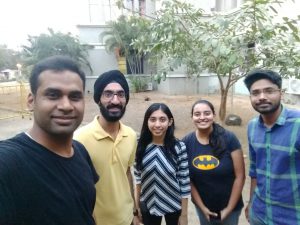
At MSE with the real changemakers. (left to right) Rishabh Yadav, Prachi Mathur, Manisha Parakh, and Manak Singh Suri.
This was my first trip to there and I was accompanied by Prof. Ramani herself on this 10 day long journey and my plunge into Kameswaram. We started from New Delhi on February 27, 2019, and made a short halt in Chennai. In Chennai, I met masters students at the Madras School of economics to discuss about their efforts for cleaning their campus with the hostel where they stay. They are actively organizing awareness campaigns about waste management, cleanliness drives around their campus and systemic changes for minimizing food waste in MSE. Followed by this we had Chinese dinner with Prof. Ramani’s family and rushed to board our train for Nagapattinam (as it turned out this was one of the many times on this trip that we had to rush not to miss a plane/train etc.)
We were in Kameswaram from February 28 to March 6. Our broad agenda for the time was to understand the nature of the damages caused by Gaja cyclone. Two new FIN interns from Madras School of Social work visited Kameswaram for one day orientation program. Shanmugarajan and I were their mentors for the day!
Day 1 : Arriving in Kameshwaram,
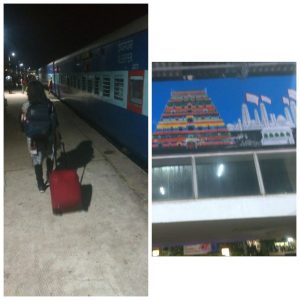
1. Arriving at Nagapattinam Railway station
Our train (Karaikal Express) which had left Chennai at 10.00pm reached (Picture 1) Nagapattinam railway station at 5.00 am in dawn. Sun was not yet out when we sat sipping coffee in a nearby restaurant. I had been introduced to Mr. Paranjothi who had come to pick us up at the railway station and both of us tried to get acquainted without much success. After a 30 min (approx.) drive (from Nagapattinam towards Velankanni) we reached FIN house in Kameshwaram (Picture 2).
On the way Prof. Ramani showed me some of the destruction caused by Gaja cyclone. Mostly heavy foliage trees (like cashew and mango) had fallen while slender trees of palm & coconut had lost some part of their crown (Picture 3).
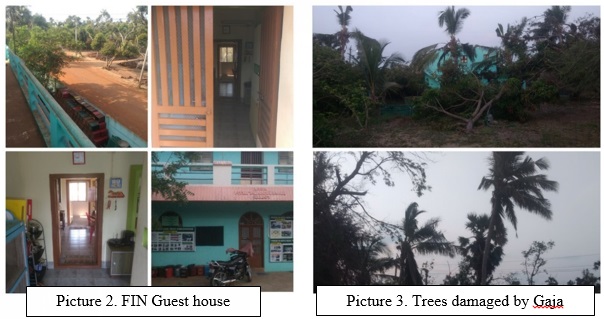
The day began after we had our breakfast, puri, idli and sambar brought from nearby Manju Mess. We looked around the compound and Prof. Ramani showed me the composting sites (Picture 4), a small hut being built for teaching and trees in FIN compound that had fallen due to cyclone. With the felling of the trees in the village, there was much more direct sunlight. A positive externality of this sudden burst of light and heat is plants which would have never sprouted otherwise, because of lack of shade, were suddenly growing. For instance, in compost a watermelon was growing! And nearby was a tomato plant which nobody had planted (Picture 5). 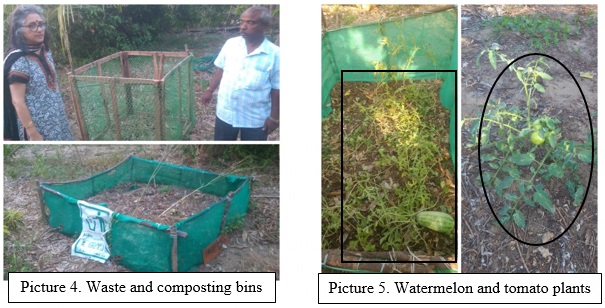
Rest of the day was spent in cleaning and reorganizing of the house. As pointed out by Prof. Ramani and by my own observation, Paranjothi Sir does not dispose used and spoiled things (papers, paint cans, electronic equipment, clothes etc), they are stashed away under his bed. So all this was to be sorted and removed from house to be sold to junk dealer (Picture 6). Meanwhile the hut was being constructed by a local worker (Picture 7), we have got a white board installed in the hut to use for teaching (Picture 8).
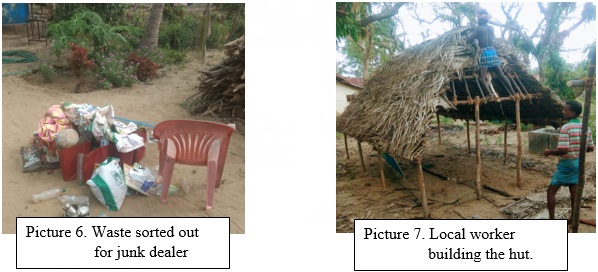
Lunch was a three course meal, all including rice. First course was rice and sambar, second course was rice and rasam, and the third course was rice and curd (Picture 9). Curd and rice have a soothing effect in the excessive heat of southern India. After this we had a nap for about 1 hour. I woke up and saw that Prof. Ramani had resumed cleaning the house with Vellalar (he is Paranjothi Sir’s cousin who is looking after the house right now) and Meena (she does housekeeping and cooking here).
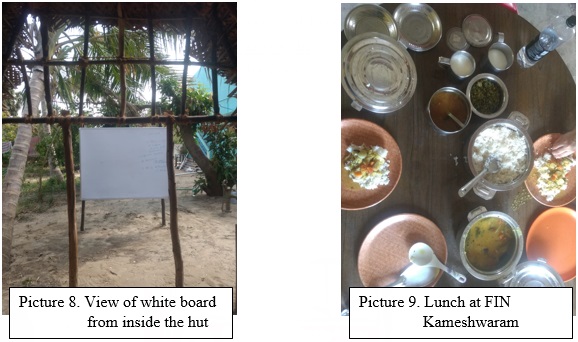
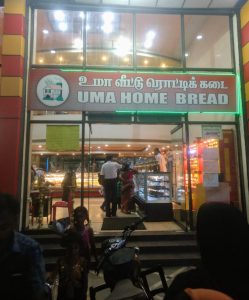
10. A view of the Uma bakery out let in Nagapattinam
After tea, Paranjothi sir took me to Nagapattinam market to get supplies for the house. On the way we halted at his sister’s home where I was offered Kerala Halwa (this is a jelly made using banana and cashews). We went to two mini supermarkets, Apple and Shiva Shakti Super Market. These are well known places in Nagapattinam. Uma Bakery in the market near Nagapattinam railway station has delicious Raagi, Coconut and other cookies, fresh baked bread, Indian sweets, Cake and pastries etc. (Picture 10). One thing we could not get to our satisfaction was a wooden shelf for Paranjothi sir’s office. By the time we were done shopping Paranjothi sir and I had become good friends and we were talking in a mix of Hindi, English and Tamil. On our way back we brought paratha and chapati meals for us. At night I sat outside in the cool breeze which was perfect to relax and gaze at clear sky filled with stars.
Day 2: Meeting the villagers and assessing the damage caused by cyclone 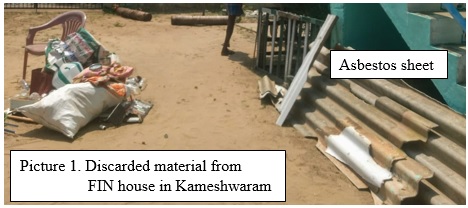
Today we continued working on cleaning the FIN guest house and getting things ready before the Interns come on day 3 for their introductory orientation programme. So the morning was spent in finishing up cleaning the house and discarding useless material, using logs from fallen trees to form bunds of flower garden etc. Among the discarded material there were old bed sheets, rusted tin dustbins, broken plastic chair, old steel utensils and an asbestos roofing sheet (Picture 1). Many among them were victims of Gaja cyclone and the neglect after it. For instance, we found that the Certificate of President’s prize Prof. Ramani had received had been destroyed due to growth of mould on the paper (Picture 2). A printer that was destroyed by the cyclone when a broken roof fell on it. After this cleaning and heavy lifting, a light meal of rice and sambar with spinach from backyard was served (Picture 3) and everyone retired for getting some rest.
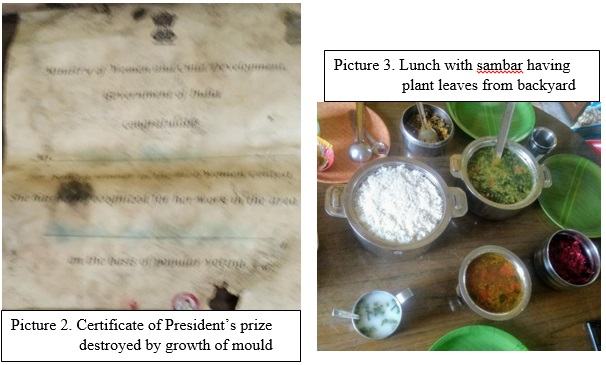
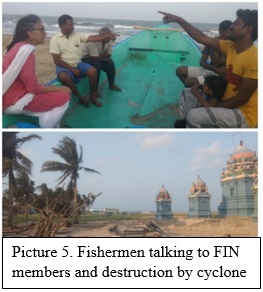
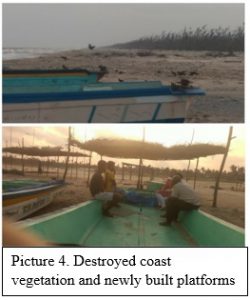 In the evening we went to the beach to meet fishermen and interview them about how they were recovering from the damage from cyclone (Picture 4). The fishermen who came to meet us were (1) Mr. Paramshivam (2) Mr. Dhanapal, two of the local fishermen who are active in representing their village and (3) a marine engineer working in the Gulf (Picture 5). They told us about the night of the cyclone and how they managed in the designated shelters. We saw that there was a lot of building waste lying around in the village. Plastic playing cards, empty and broken liquor bottles, broken slippers, discarded fishing nets and
In the evening we went to the beach to meet fishermen and interview them about how they were recovering from the damage from cyclone (Picture 4). The fishermen who came to meet us were (1) Mr. Paramshivam (2) Mr. Dhanapal, two of the local fishermen who are active in representing their village and (3) a marine engineer working in the Gulf (Picture 5). They told us about the night of the cyclone and how they managed in the designated shelters. We saw that there was a lot of building waste lying around in the village. Plastic playing cards, empty and broken liquor bottles, broken slippers, discarded fishing nets and
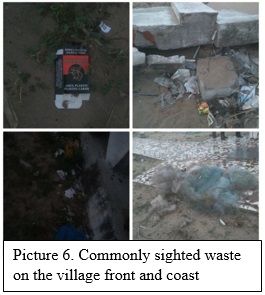
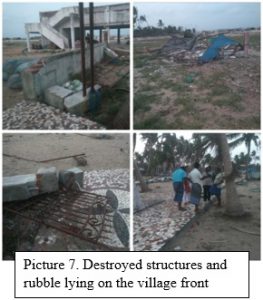
empty plastic packets were easy to spot in the sand of the beach (Picture 6). Many children and young men were spotted practicing open defecation on the shore which is about 200m from the village. Many walls and tin sheds that broke during the cyclone were left untouched (Picture 7). On our way back we saw a few big houses which signified the heterogeneity of the population.
After returning from the village, we sat in front yard and everyone was inspired to paint a structure of fish in the yard. All of us picked up a brush and a can of paint and without much thought or planning finished painting the fish. Vellalar was drawing the outlines in red, Prof. Ramani added details in yellow, I picked black paint and placed a few spots on the fish’s body, and Paranjothi sir with strokes of white added the eye and fins of the fish (Picture 8).
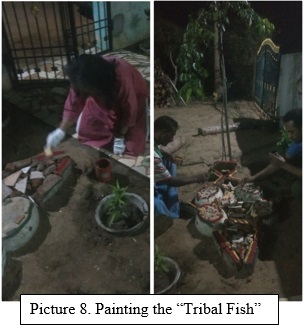
Day 3: First encounter with an EcoSan toilet
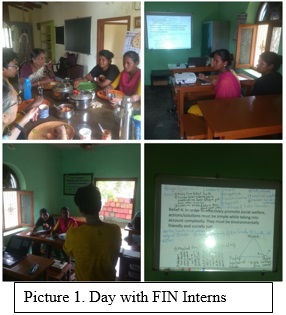 When I woke up, the guests had arrived and there was a lot of activity around the FIN house. I was introduced to new interns by Prof. Ramani. Soon after the house tour and breakfast, the orientation session was started. Shanmugam and I were tasked with conducting the session while Prof. Ramani was sitting in the back and providing inputs. It was an interesting session of introduction and story-telling (Picture 1). Afternoon was spent on discussing and streamlining the internship project and activities to be performed by the students during their stay in Kameswaram. Later on we took the interns to see the village and introduced them to volunteers in the village. While walking we saw many fields which were using ecological fencing (Picture 2). In contrast to this, new houses that are being built have heavy use of bricks and tin sheets for roofing. These sheets are easy to install and long lasting under normal conditions, hence, have lower maintenance costs. However, in summer, it can get very hot during the day as opposed to thatched roofs.
When I woke up, the guests had arrived and there was a lot of activity around the FIN house. I was introduced to new interns by Prof. Ramani. Soon after the house tour and breakfast, the orientation session was started. Shanmugam and I were tasked with conducting the session while Prof. Ramani was sitting in the back and providing inputs. It was an interesting session of introduction and story-telling (Picture 1). Afternoon was spent on discussing and streamlining the internship project and activities to be performed by the students during their stay in Kameswaram. Later on we took the interns to see the village and introduced them to volunteers in the village. While walking we saw many fields which were using ecological fencing (Picture 2). In contrast to this, new houses that are being built have heavy use of bricks and tin sheets for roofing. These sheets are easy to install and long lasting under normal conditions, hence, have lower maintenance costs. However, in summer, it can get very hot during the day as opposed to thatched roofs.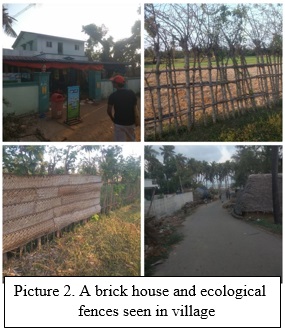
In the village, we saw an EcoSan toilet cum bathroom constructed by FIN. Here local ladies came and told us of their challenges after the cyclone and how they faced the night when the cyclone had hit the village (Picture 3).We walked with a local lady representative Anjammal, who took us outside the village to show how far the women have to go for defecation. We also visited Anjammal’s house as she has been requesting FIN to build a toilet for her. After returning from the village, the interns left to return to Chennai.
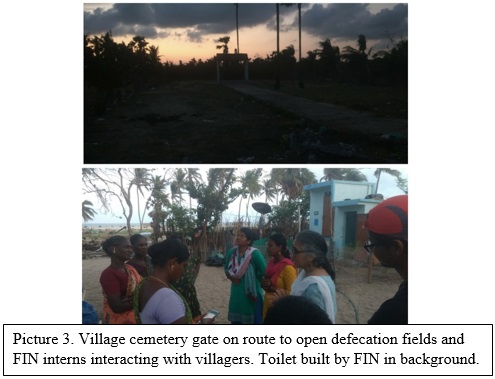
Day 4: Participating in my first community meeting, a story about Kameswaram and the FIN team
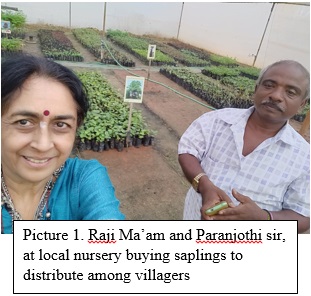 After saying good bye to our new interns after a long day 3 orientation programme we got ready to welcome Raji madam, another member of FIN India. I personally was looking forward to meeting her as I had heard soo much about her from Prof. Ramani. Pleasantly, she announced her arrival on Finnies as soon as she reached Nagapattinam and brought with her parathas for all of us (Picture 1).
After saying good bye to our new interns after a long day 3 orientation programme we got ready to welcome Raji madam, another member of FIN India. I personally was looking forward to meeting her as I had heard soo much about her from Prof. Ramani. Pleasantly, she announced her arrival on Finnies as soon as she reached Nagapattinam and brought with her parathas for all of us (Picture 1).
A community engagement meeting was held in which Prof. Ramani and Shanmugan talked to 5 representatives from village about the villagers acting as FIN volunteers. As it was realized that FIN had no teams to respond to emergencies like cyclones ~ the main target of 2019 is to build a network of volunteers, 2 from each ward to be ready for future emergencies. As a gift for coming. The volunteers were also given saplings to plant around houses (Picture 2). It was revealing that out of 20 volunteers we could convince only 5 to come to the meeting. Thus, a major challenge for the local team would be to manage to have community action group meeting with near full attendance.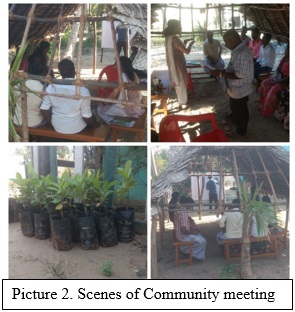
After the meeting, Prof. Ramani told us about the story about Kameswaram as we strolled through the neighborhood (Picture 3). “It is said that there was a dedicated son who was carrying his father’s ashes to Varanasi, as this has been his father’s wish. One day when he was resting an old man (who was in fact a god, appeared and asked for food). The boy had limited food but he offered his food explaining that the old man was like his father and he was happy to help. The god showed his true form and told the boy to keep moving. At a certain place his father’s ashes would turn into flowers. This place would be as holy as Varanasi. This place was Kameswaram.”
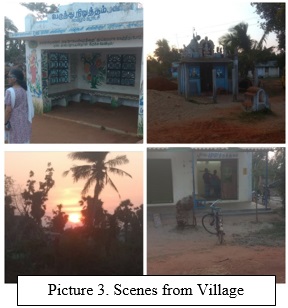
We also had introduction sessions with the FIN staff members. Following are short descriptions about them.
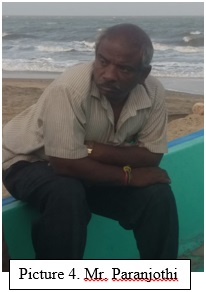 Mr. Paranjothi (Picture 4): Also known as The Pearl and Mr. Fix-it, Paranjothi sir is the cheif administrator of FIN Kameshwaram. He is responsible taking care of guest house, distributing chores, supervising other staff members, organizing resources, informing and interacting with the villagers and hiring masions to build toilets in the village. This time he has also assumed the duty of being our driver. He is in mid 40s and has a son who he loves very much.
Mr. Paranjothi (Picture 4): Also known as The Pearl and Mr. Fix-it, Paranjothi sir is the cheif administrator of FIN Kameshwaram. He is responsible taking care of guest house, distributing chores, supervising other staff members, organizing resources, informing and interacting with the villagers and hiring masions to build toilets in the village. This time he has also assumed the duty of being our driver. He is in mid 40s and has a son who he loves very much.
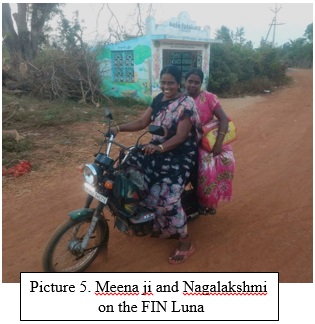
- Meena ji (Picture 5): She is a very strong and sweet woman who rides the FIN Luna to come to work. Her job is the most important as she cooks for us and keeps the house clean. Meena ji has worked in Singapore, where she worked in a hotel in Little India.
- Nagalaxmi ji (Picture 5): She is the companion of Meena in housekeeping and cooking. These two ladies together cook most amazing idlis, dosa and a new kind of stew for every meal. They have used plants from the backyard to make delicious food.
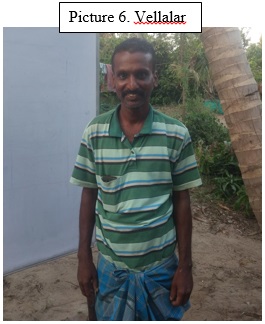
4. Vellalar (Picture 6): He is the latest member of FIN team at Kameshwaram. He is a cousin of Mr. Fixit and like him has also returned from Gulf after working there. He is assuming the position of handyman as his skills include those of a Gardner, an Electrician and a Mason.
After the day was over all sat down and Prof. Ramani cooked Maggi for everyone. We had dinner featuring maggi, rice, rasam, lentils and buttermilk.
It was 9 pm and Shanmugan had to leave for Chennai to resume his job after the weekend. As he and Mr. Paranjothi left the day at FIN Kameshwaram came to a close.
Day 5: Field work, noise pollution and an adventure averted by the dogs.
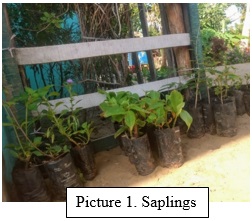 After 4 days of labour we had thought that all the physical work was now complete and we will get to writing reports and formulating future vision documents for FIN Trust. However, on this Monday morning our plan to visit Chinmaya Mission School in Nagapattinam was postponed as it was Shiv Ratri (A day when Lord Shiva is worshiped and it is a holiday), so we turned to planting some of leftover saplings from the community meeting in the guesthouse backyard (Picture 1). Rest of the saplings were distributed to neighbours, and to a cycle shop owner as a gift. This gentleman was kind enough to let us take old tyres from his shop for fencing newly planted saplings in the guesthouse. We were carrying these tyres when a boy about 8yrs came and asked Prof. Ramani to give him a few plants. However, in excitement, he ran to his house and we could not find him. So after looking around for some time we came back to guest house with our tyres.
After 4 days of labour we had thought that all the physical work was now complete and we will get to writing reports and formulating future vision documents for FIN Trust. However, on this Monday morning our plan to visit Chinmaya Mission School in Nagapattinam was postponed as it was Shiv Ratri (A day when Lord Shiva is worshiped and it is a holiday), so we turned to planting some of leftover saplings from the community meeting in the guesthouse backyard (Picture 1). Rest of the saplings were distributed to neighbours, and to a cycle shop owner as a gift. This gentleman was kind enough to let us take old tyres from his shop for fencing newly planted saplings in the guesthouse. We were carrying these tyres when a boy about 8yrs came and asked Prof. Ramani to give him a few plants. However, in excitement, he ran to his house and we could not find him. So after looking around for some time we came back to guest house with our tyres.
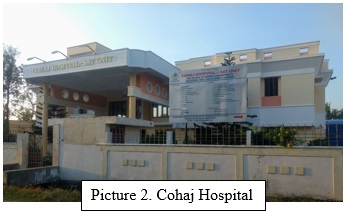 In the afternoon we went to meet head sister at a nearby church run hospital (cohaj hospital) (Picture 2) to ask for help in managing the FIN guest house. On our way back we stopped for talking to St. Sebastian school teachers and girl students about summer school in may. The girl students showed interest in playing cricket at summer camp and teachers were ready to help us in conducting these camps (Picture 3- omitted). We expect that the interns and local FIN team will be able to conduct these camps with the students and teachers, but this will need significant effort from outside team also to ensure that local team remains in touch with the school administration to plan and conduct these summer camps. In the evening we went to visit villagers who have approached FIN to repaire their toilet or house.
In the afternoon we went to meet head sister at a nearby church run hospital (cohaj hospital) (Picture 2) to ask for help in managing the FIN guest house. On our way back we stopped for talking to St. Sebastian school teachers and girl students about summer school in may. The girl students showed interest in playing cricket at summer camp and teachers were ready to help us in conducting these camps (Picture 3- omitted). We expect that the interns and local FIN team will be able to conduct these camps with the students and teachers, but this will need significant effort from outside team also to ensure that local team remains in touch with the school administration to plan and conduct these summer camps. In the evening we went to visit villagers who have approached FIN to repaire their toilet or house.
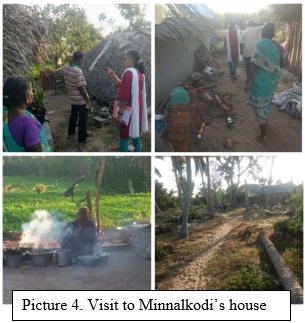 First was Minnalkodi’s house, which was damaged during Gaja cyclone. Now she lives with her mother in a one room with two daughters. She is the woman who cleans and looks after village bus stop restored by FIN and Chinmaya School students in 2016 (Picture 4). Minnal belongs to a proportion of village which is landless and works on land that is owned by temple of Thiruppundi. Temple representatives take 50% of produce from these lands as fees for the land.
First was Minnalkodi’s house, which was damaged during Gaja cyclone. Now she lives with her mother in a one room with two daughters. She is the woman who cleans and looks after village bus stop restored by FIN and Chinmaya School students in 2016 (Picture 4). Minnal belongs to a proportion of village which is landless and works on land that is owned by temple of Thiruppundi. Temple representatives take 50% of produce from these lands as fees for the land.
The other villagers who had approached us for repairing and building their toilets were next on our list. Mr. Sridhar (who had the first model eco-san toilet built by FIN) told us that nearby villagers had constructed soak pit toilets. However these soak pits were malfunctioning and the ground water has been contaminated by the water from the pits (Picture 5).
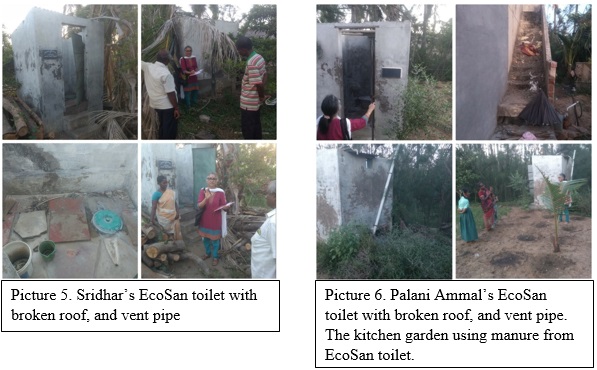
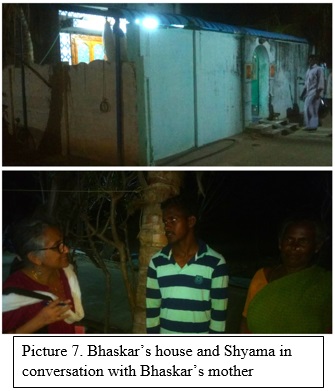
We then saw an example of model use of eco-san toilet at Palani Ammal’s house. They are using manure from the toilet to grow flowers, select vegetables and other plants in their kitchen garden(Picture 6). The final visit for the day was to meet Mr. Bhaskar who has a house next to the see(Picture 7). His mother wants to build a ecosan toilet for their daughter in law before she comes to live in the house. At the nearby temple there was deafening music being played for the festival day. As we asked Bhaskar and others around the Priests had themselves left the temple after putting on the music. It was evident that how discomforting the loud music would be to the residents but no one had said anything to the priests or tried to get the music stopped.
After this we made a futile attempt (@shanmugan) to walk to the first Supermarket concept store that has opened in Kameswaram. As it was already dark, we were apprehensive and as the dogs started barking frantically we decided it was best to go back to the guest house and utilize the services of Mr. Paranjothi to drive us to the store.
Day 6 and 7: Visiting Chinmayananda vidyalaya, shopping, and on Mr. Paranjothi’s secret talent.
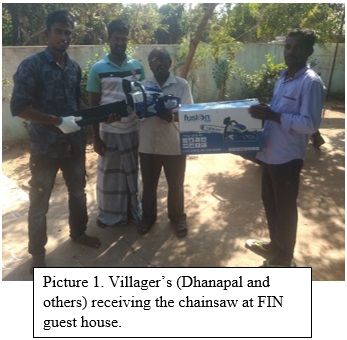 The last two days at Kameswaram were spent in setting up the guest house and preparing the local team for the activities planned in rest of the year. On day 6, we had decided that we will go to Nagapattinam and Karaikal for purchasing Jio Mobile phones a chainsaw for the Fishermen (Picture 1) as they did not receive any help from FIN trust after the cyclone and they felt that they were purposely neglected. At about 8 am Prof. Ramani, Mr. Paranjothi and I left for Nagapattinam with a plan that we will meet Swami ji at Chinmayananda vidyalaya and come back before lunch time.
The last two days at Kameswaram were spent in setting up the guest house and preparing the local team for the activities planned in rest of the year. On day 6, we had decided that we will go to Nagapattinam and Karaikal for purchasing Jio Mobile phones a chainsaw for the Fishermen (Picture 1) as they did not receive any help from FIN trust after the cyclone and they felt that they were purposely neglected. At about 8 am Prof. Ramani, Mr. Paranjothi and I left for Nagapattinam with a plan that we will meet Swami ji at Chinmayananda vidyalaya and come back before lunch time.
We reached the school when the morning assembly was being conducted. After the assembly we met Swamiji and the school staff and explained to them about the green academy project and asked for collaboration in conducting cleaning walks at Kameshwaram beach (Picture 2). We also saw the computer laboratory of the school which is state of art (Picture 3) and can be used as model teaching laboratory in other schools.
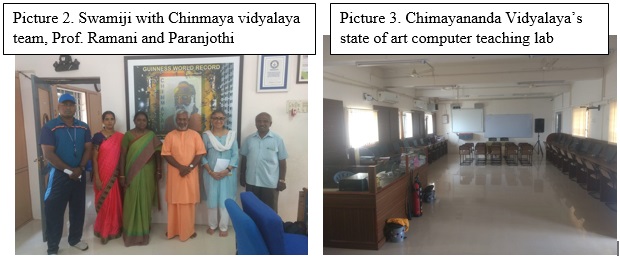
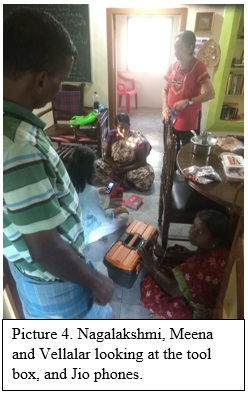 After talking to the teachers at school we realised that we might get the mobile phones and chainsaw in Nagapattinam and thus we would not have to go to Karaikal. Following the directions given by them we were at the Jio store in a few minutes. However we did not know how much time we were about to spend at this shop. It was noon by the time we were able to leave this shop and go to nearby hardware store to buy chainsaw for fishermen, measuring tape to use for camp activities, knife sharpening stone for the ladies to use, and a toolbox for Mr. Vellalar to keep the tools which were laying outside in the guest house. After all the shopping was done we went to Uma bakery to buy cookies and sweets to take back with us. This too was an “adventure” as we decided that we can get a weighing machine to be used for student activities and a desert cooler for the guest house as some foreign volunteers had pointed out that the heat is unbearable during peak summer season.
After talking to the teachers at school we realised that we might get the mobile phones and chainsaw in Nagapattinam and thus we would not have to go to Karaikal. Following the directions given by them we were at the Jio store in a few minutes. However we did not know how much time we were about to spend at this shop. It was noon by the time we were able to leave this shop and go to nearby hardware store to buy chainsaw for fishermen, measuring tape to use for camp activities, knife sharpening stone for the ladies to use, and a toolbox for Mr. Vellalar to keep the tools which were laying outside in the guest house. After all the shopping was done we went to Uma bakery to buy cookies and sweets to take back with us. This too was an “adventure” as we decided that we can get a weighing machine to be used for student activities and a desert cooler for the guest house as some foreign volunteers had pointed out that the heat is unbearable during peak summer season.
By the time we finished with the shopping all three of us were very exhausted and craving for cold water, drinking which possibly caused Prof. Ramani to suffer a sore throat for about a week (Comment from her: “I lost my voice!!! and it took 2 weeks to come back – surely mild sunstroke!). All the material was brought and showed to the ladies (Nagalakshmi and Meena) and Mr. Vellalar (Picture 4).
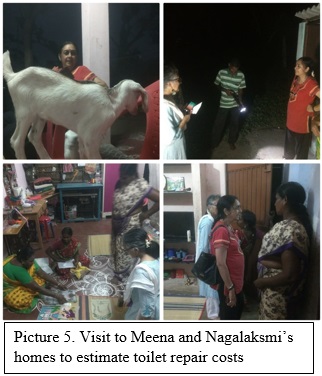 On the evening of day 6 we went to Meena’s and Nagalaxmi’s homes to assess the requirements for building toilets there. We were introduced to Meena’s elder sister, two dogs and two goat kids who kept roaming around us and trying to eat the cane mat on which we were sitting (Picture 6). At Nagalaxmi’s home we met her son who is in secondary school and daughter who is about to take her class 11th exams. After these two visits the day was over.
On the evening of day 6 we went to Meena’s and Nagalaxmi’s homes to assess the requirements for building toilets there. We were introduced to Meena’s elder sister, two dogs and two goat kids who kept roaming around us and trying to eat the cane mat on which we were sitting (Picture 6). At Nagalaxmi’s home we met her son who is in secondary school and daughter who is about to take her class 11th exams. After these two visits the day was over.
On final day we packed our bags, made arrangements in the guest house so that when the two interns from Madras school of social work come to stay, they are able to adjust well. After cleaning and reconfiguring one bed room in the guest house, there was a Zumba session in which we were treated to Mr. Paranjothi’s hidden talent, and helped the ladies setup their new phones. Prof. Ramani made personalised videos on each members phone about their role in FIN trust and the evolution of FIN initiative over time. This is an important step in capacity building in FIN team towards enabling them through skills building and creating a sense of purpose. Through this exercise we expect that the limitations caused by patriarchal community setup and lack of local leadership will be addressed and next time we visit the guest house, the first two days will not be spent in cleaning the guest house.
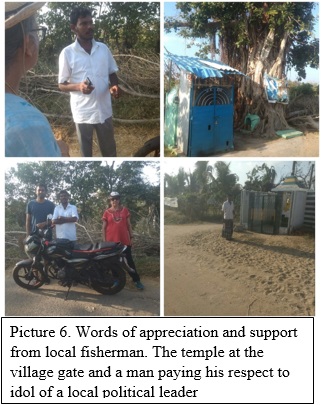 Besides this we also had a morning walk around the village where we were greeted by villagers most of which knew that FIN was operational NGO in the village but very few knew about the work FIN is doing and has done in the past. This meant that our previous observation about lack of local representation and rapport with villagers are potential action areas we need to work upon to improve our visibility and community engagement. A gentleman fisherman (who was returning after dropping his daughter to school) who possibly confused me for Mr. Shanmugan, stopped and told us that he was happy that we were trying to help the villagers (Picture 6).
Besides this we also had a morning walk around the village where we were greeted by villagers most of which knew that FIN was operational NGO in the village but very few knew about the work FIN is doing and has done in the past. This meant that our previous observation about lack of local representation and rapport with villagers are potential action areas we need to work upon to improve our visibility and community engagement. A gentleman fisherman (who was returning after dropping his daughter to school) who possibly confused me for Mr. Shanmugan, stopped and told us that he was happy that we were trying to help the villagers (Picture 6).
At the end of the day, Mr. Paranjothi dropped Raji Madam to Nagapattinam from where she took her bus and came back to take us to Nagapattinam for our train to Chennai.
Our Chennai plan was also cut short as our flight from Chennai to Delhi with Jet Airways was cancelled and we had to take an earlier flight with Indigo airlines.

